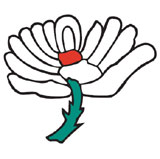Formed 1863
First-class debut 1864
Admitted to Championship1890
County Championship 1893, 1896, 1898, 1900, 1901, 1902, 1905, 1908, 1912, 1919, 1922, 1923, 1924, 1925, 1931, 1932, 1933, 1935, 1937, 1938, 1939, 1946, 1949(Shared), 1959, 1960, 1962, 1963, 1966, 1967, 1968, 2001
Gillette/NatWest/C&G 1965, 1969, 2002
Benson & Hedges 1987
Sunday League 1983
Twenty20 Best - Quarter-finals 2006
No county has enjoyed as much Championship success as Yorkshire nor have any attracted more comment or controversy.
The game itself had been played in the Yorkshire since the mid 18th century, but the county club was only officially formed in 1863, even though a selection committee had been in place for two years. Also, the side had already engaged in their first Roses match (1849) and was loosely based at Sheffield.
For the next couple of decades Yorkshire's fixtures were irregular and performances similar. There were many talented individuals - Tom Emmett and Ted Peate to the fore - but results were disappointing, and by the 1880s murmurings of discontent were growing.
In 1883 Lord Hawke- ironically, given the county's almost fanatical refusal to allow anyone not both with the boundaries to play for them, not a Yorkshireman - took charge. While no great player himself, he forged a side so powerful that it dominated the game for almost eighty years.
It took Hawke time to turn the tide, and in 1893 he broke the stranglehold held by Sheffield and, coincidently, in the same season Yorkshire won their first Championship. Hawke had forged a side built on ferocious loyalty and teamwork. In 1896 they won again, one of six titles and three runners-up slots in the next decade. George Hirst and Wilfred Rhodes led the way, and in 1906 Hirst scored 2386 runs and took 208 wickets.
A slight downturn before World War One was merely a blip, and between the wars the Championship was won 12 times and the county were never out of the top five. Between 1922 and 1925 they lost only six times in 122 matches and immediately before World War Two they won seven titles in nine seasons. It was not hard to see why. Rhodes continued until 1931, by which time he was 51, and he was joined by Emmott Robinson and Bill Bowes. In Hedley Verity they possessed a truly great spinner, and between 1930 and 1939 he took 1558 wickets. Herbert Sutcliffe and Percy Holmes forged a solid opening partnership (they set the world record opening stand of 555 against Essex in 1932) and Maurice Leyland provided mid-innings flair while len Hutton emerged shortly before the cessation.
Their success continued with another success when the Championship resumed in 1946, but a shared title in 1949 was to be their only other success until the 1960s. While Surrey dominated the 50s, Yorkshire finished second to them four times. But a membership used to success was not happy and neither was the dressing-room and stories of rows were common. Things reached a head when Johnny Wardle, a supremely talented spinner, was sacked in 1958 for newspaper comments criticising the club. Nevertheless, in 1960 the county appointed their first professional captain and with Fred Trueman and Brian Close leading the way, and Geoff Boycott churning out runs, the 1960s was a good decade.
Those troubles were forgotten in the 1960s as six titles came in eight years, and they even added a couple of Gillette Cup wins for good measure. But all was not well and the seeds of discontent were growing.
Promising talent did not come on; the county contrived to lose a number of their better players - including Ray Illingworth, John Hampshire and most controversially Close - and they failed to embrace a changing world where one-day cricket was usurping the three-day game. And, crucially, other counties drafted in top cricketers from abroad while Yorkshire steadfastly stuck to their Yorkshire-only policy.
Close's departure in 1970s triggered the first of seemingly innumerable members' revolts, and the captaincy of Boycott poured high-octane fuel on the fire. While he led by example, he utterly polarised opinion. The county won nothing and it often seemed that Boycott's role in the county mattered more than the team itself.
The 1980s were no better, although there was the solace of one B&H and one Sunday league win. In 1991 the county bowed to the inevitable and voted to allow players not born in the county to represent them, although it took another year for overseas players to be signed - Sachin Tendulkar was the first.
There was no dramatic turnaround in their fortunes, however, but in 2001 David Byas led the side to the Championship, and the C&G Trophy followed a year later. But again success came at a price, as the club reported record losses and inevitable cut-backs followed.
In 2005 the club bought Headingley, where they had been unhappy tenants for many years, a move which landed them with a heavy debts but meant that finally they could earn money from their home.
History to follow
Martin Williamson is managing editor of Cricinfo
